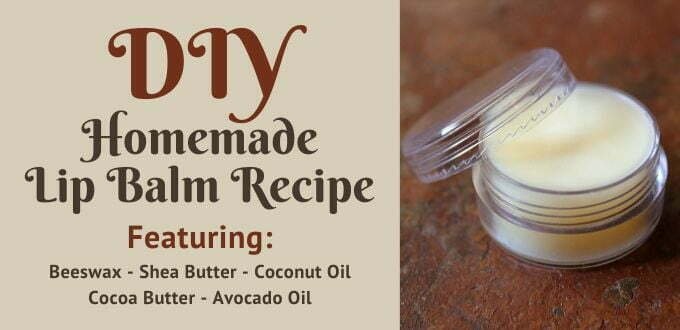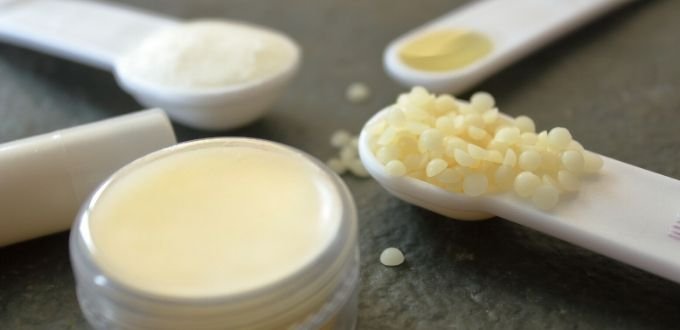
DIY homemade lip balm is fun to make. I love to make it. My wife loves to make it. My kids love to make it.
Why?
Because homemade lip balm is inexpensive, fun to make, and is customizable. Plus, it only takes a few minutes to turn out a batch that will last you for months.
The lip balm recipe I am going to show you is my favorite recipe. It contains a variety of carrier oils in a beeswax base that will produce a nice silky-smooth lip balm. It melts with a slight rub with your finger and you can use it in tube containers. This recipe also works well flavorless or you can add flavoring and color as you see fit.
I love this recipe and I am sure you will too!
Ready to get started?
(Also try: Homemade Lip Balm Recipe With Olive Oil, Coconut Oil, Orange Vanilla Flavoring, Peppermint oil, and Beeswax)
Homemade Lip Balm Ingredients:
Here is a list of the ingredients you will be using for your DIY lip balm. I have provided a quick rundown of the properties and benefits of each ingredient. This will help to give you a better understanding of why this recipe works as well as it does.
See also: Note: Primary Ingredients for Homemade Lip Balm

Beeswax Pellets:
Beeswax is the base ingredient for most homemade lip balm recipes. It helps soothe and protect lips, helps to lock in moisture, and has a slight antibacterial effect.
You can use either refined or unrefined beeswax. Unrefined beeswax has a yellow color and a light to heavy honey flavor. Depending on the source. Refined beeswax should be off white to white with little to no flavor.
Beeswax has a melting point of 144 to 147°F (62 to 64°C) and you should melt it first before all oils. In a solid-state, it is quite hard and does not melt on skin contact.
Cocoa Butter:
Cocoa butter is an emollient that helps soothe, moisturize, and protect chapped lips. It reduces inflammation, improves skin elasticity, and increases skin thickness.
You will find that cocoa butter has the same refined and unrefined options as beeswax. Unrefined cocoa butter has a heavy cocoa smell and a brownish color. Refined cocoa butter is whiter with the flavor removed.
Cocoa butter is solid at room temperature and has a melting point of 93–101°F (34–38°C ). It takes longer to melt at body temperature than shea butter but has a nice creamy feel to the oil when it does.
Shea Butter:
Like cocoa butter, shea butter is an emollient that softens, soothes, and protects lips. It contains skin revitalizing vitamins A & E as well as skin-nourishing fatty acids. Shea helps to reduce inflammation and provides UV protection.
You also have the option to use refined or unrefined shea butter. Unrefined shea butter can have a smoky nutty smell and an ivory color. Refined shea butter is white with little to no flavor.
Shea butter is solid at room temperature and has a melting point of 89-100°F (31–37°C ). The lower melting of shea butter makes it ideal for body temperature melting.
(Note: Shea butter can crystallize and turn gritty if it isn’t melted at the higher end of the melting point and cooled too slow.)
76-Degree Coconut Oil:
As the name suggests 76-degree coconut oil has a melting point of 76°F (24°C). It melts fast on skin contact. It makes a great offset to the hard beeswax it gets mixed with. Together with beeswax, it produces a smooth silky texture. So, I use it as a primary base for most of my DIY lip balms.
Coconut oil is high fatty acids and vitamin E that helps nourish lips. It is very soothing to chapped lips. It promotes healing and has antimicrobial properties that can protect your skin from infection.
76-degree coconut oil can be refined or unrefined. Unrefined coconut oil will have a natural coconut smell and an ivory color. Refined coconut oil is whiter and has little flavor.
Avocado Oil:
Avocado oil has many beneficial properties. It is liquid at room temperature, high viscosity, and slow absorbing. It will sit on your skin for a long period of time. This helps to hydrate and soothe sore burning lips. It also creates a protective layer from wind and UV light. Avocado oil is anti-inflammatory and high in antioxidants. This helps to heal and replenish damaged skin.
I use the same avocado I cook with. It works great in all my DIY lip balms.
Tip: Use refined oils and butter if you plan to add flavors and colors to your lip balm
The Lip Balm Recipe:
The lip balm vials I use are 15ml. Converted to U.S. tablespoons would be roughly 1 tablespoon or 3 teaspoons. The tube containers I use are 4.4ml but you can find them in up to 5.5ml sizes. Roughly 5ml or 1 teaspoon. This recipe would make about 3 tubes of lip balm.
For U.S. tablespoons the ratio of beeswax to oils/butter is 1:3. For milliliters, the ratio of beeswax to oils/butter would be 1:4. It comes out to even measurements and makes it easier to scale up. For example:
In U.S. tablespoons the 1:3 ratio would equal to ¾ teaspoon beeswax to 2 ¼ teaspoon oils/butter to equal 1 tablespoon of lip balm. Which equals 1 vial or 3 tubes of lip balm.
In milliliters, the 1:4 ratio would equal to 3 milliliters beeswax to 12 milliliters of oil/butter. Totaling 15ml for 1 vial or 3 tubes of lip balm.
To make one 15ml (1 tbsp) vial of lip balm (three 5ml (1 tsp tubes)) would be as follows:
U.S. Tablespoon/teaspoon variation:
- 3/4 tsp beeswax pellets
- 1/4 tsp shea butter
- 1/4 tsp cocoa butter
- 1 tsp 76-degree coconut oil
- 3/4 tsp avocado oil
- Add coloring and flavor as needed
Metric variation:
- 3ml beeswax pellets
- 2 ml shea butter
- 2ml cocoa butter
- 5ml 76-degree coconut oil
- 3ml avocado oil
- Add coloring and flavor as needed
How to make the lip balm:
You will need a double boiler to make your homemade lip balm. I use a medium-sized pot with a few cups of water and a glass measuring cup with a handle and a pour spout. This setup works great for me and makes it easy to pour the liquid lip balm into containers.
Note: use a hot pad as the handle can get very hot.

- Bring the water to a boil and add the beeswax pellets to the empty measuring cup or upper part of your double boiler. Melt the beeswax completely.
- After the beeswax has melted, reduce heat then add cocoa butter, shea butter, coconut oil, & avocado oil.
- Allow everything to melt completely.
- At this point, you can add flavoring, essential oils, or coloring and mix. I like to use a couple of drops of peppermint essential oil for a cooling effect.
- With a hot pad, remove the upper part of the double boiler (glass measuring cup) and fill your lip balm vial(s) or tubes.
- Allow your lip balm to cool and set up enough to move them into the refrigerator or freezer.
- In about 10 minutes your lip balm should be ready to use.
That is all you have to do to make your own lip balm!
This recipe is really simple and only takes about 5 minutes. It is easy to scale up for larger batches also.
Play around with it. Add all kinds of flavors or even glossy colors if you wish. Have fun!
Also, don’t forget about this recipe. Save it to Pinterest!

